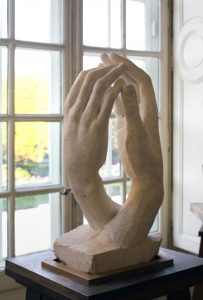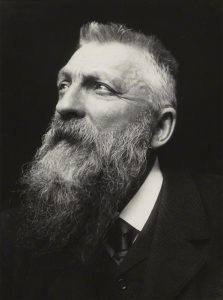One of my favorite artworks was made by the French artist, Auguste Rodin (1840–1917). His sculpture called “The Arc of the Covenant” or “The Cathedral,” shows two intertwined right hands gently touching each other.

This stone sculpture, which Rodin later cast in bronze, has the effect of creating a mysterious inner space in the area between the hands. The delicate space between the hands is like a sanctuary that, even in photographs, conveys a sense of peace, gentleness, and love. The expressive way the fingers delicately touch each other is heightened through Rodin’s skillful use of empty space. Rodin was fascinated by the partial figure and understatement; accordingly, what he does not show us (who are these people, what are the rest of their bodies like, what is the story behind it?) becomes as important as what he allows us to see, even as silence can often convey more than words.
In this work, Rodin has somehow achieved the impossible: creating a simultaneous sense of movement and stillness, desire and contentment, unity and differentiation, passion and tenderness, energy and rest.

A sculpture like “The Cathedral” does many things for us and in us and to us, and yet its value as an artwork—that which makes it good art—is independent of the viewer. I do not need “The Cathedral” to do anything for me for it to be valuable, just as God did not need to do anything productive when He rested on the seventh day; instead, the work invites us to just be present with it, to contemplate, to be “leisurely” in the presence of great beauty. Like all good art, “The Cathedral” is a work of grace, liberating us from the fixation with instrumentality and technique that have become the hallmarks of the economy of purpose.
I have never seen “The Cathedral,” in person, although when I first saw a picture of it on a documentary, I was overwhelmed with feelings I couldn’t put into words and which I still struggle to articulate. I felt like I was being initiated into a profound mystery about being human—a mystery that hovered just beyond the reach of conscious thought like waking from a beautiful dream that you can’t quite remember.
I encourage you to watch a video in which the French sculptor, Fleur Nabert, discusses Rodin’s masterpiece.

